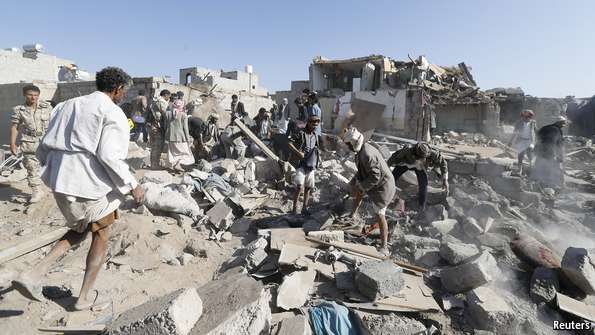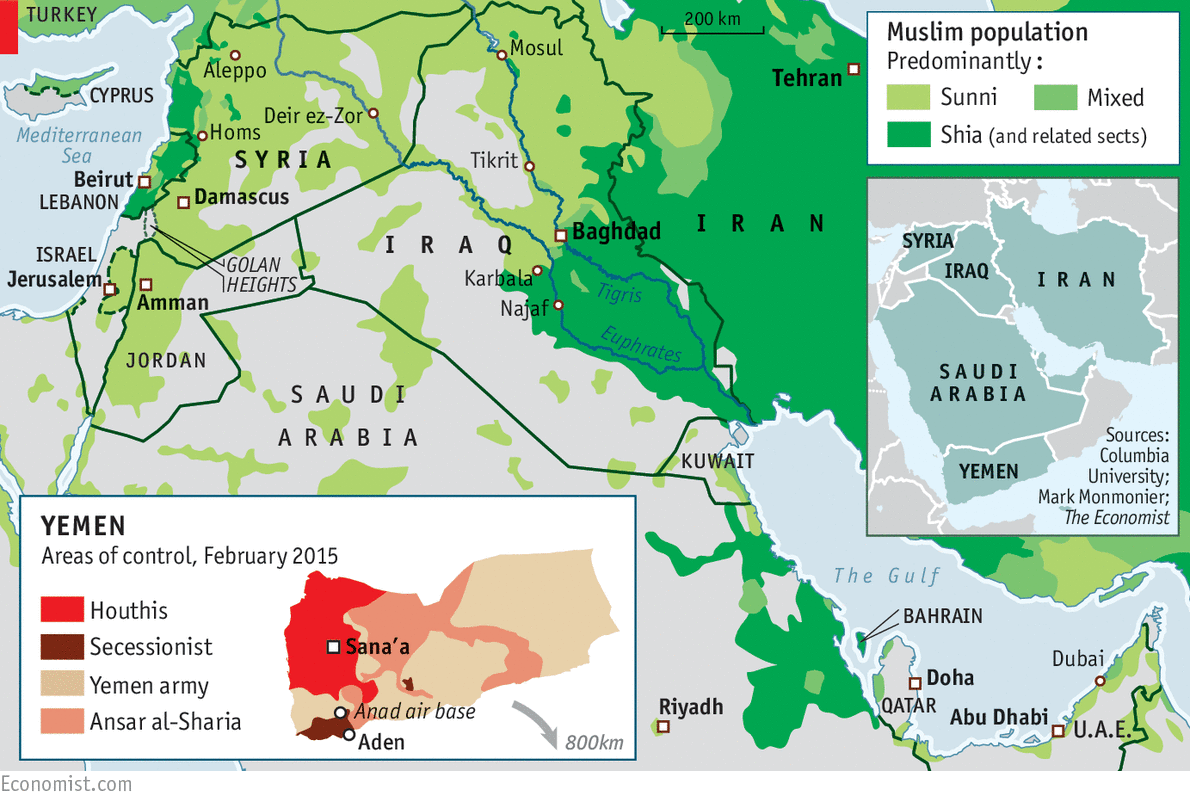
SAUDI ARABIA was only going to tolerate the advances of the Iranian-backed Houthi rebels for so long. Early on the morning of March 26th the kingdom said it had started a military operation in neighbouring Yemen to push back the Houthis and reinstate the “legitimate government” of President Abd Rabbo Mansour Hadi.
The first air strikes hit Houthi positions in Sana’a, the Yemeni capital, including the airport and the group’s political headquarters. They also targeted military bases controlled by loyalists of Ali Abdullah Saleh, Yemen’s former president, who was ousted in 2011 and has been backing the Houthis, a Shia militia that occupied Sana’a in September and has rapidly taken over swathes of the country.
Adel al-Jubeir, the Saudi ambassador to America, says the strikes are the opening salvo in a campaign involving ten countries—mainly Gulf states as well as Jordan and Egypt. America said it was providing logistical and intelligence support.
The Saudi-led intervention comes after an advance by forces loyal to Houthis and Mr Saleh towards Aden, a strategic southern port to which Mr Hadi had fled earlier this year after the fall of the capital. The Houthi advance worries Saudi Arabia because the militiamen are backed by Iran, its main strategic rival for influence in the region (see article). As the Houthis have moved south, so Iran’s support for them has increased. Tehran recently announced twice-daily flights to Sana’a and said it will supply Yemen with oil.
When the Houthis advanced, taking an important military installation 60km (35 miles) northwest of Aden, Mr Hadi was rumoured to have fled again, this time to Riyadh, the capital of Saudi Arabia. He called for military intervention before he left. Yemenis fear that the Saudi action will catalyse the country’s long-predicted collapse into what Jamal Benomar, the UN envoy to Yemen, has described as an “Iraq-Libya-Syria” scenario.
The air strikes have laid bare the divisions caused by the Houthis’ rise. In the south of the country and in northern tribal areas populated by Sunnis, who fear dominance by the Houthi’s Zaydi sect (a subset of Shia Islam), people are cheering the Saudi-led campaign.
But in Sana’a even the Houthis’ sternest critics are dismayed by the foreign bombardment. Many Yemenis believe it will only lead to more fighting. “Saudi Arabia is fucking our country,” says a Sunni tribesman who spent the night cowering with his family in Sana’a as blasts echoed through the capital.
The anti-Houthi groups’ wish is not to bring back Mr Hadi—a man who ceded control of the capital without a fight six months ago; it is that the Houthi menace be brought to heel.
Yet Saudi Arabia’s attempt to bring this about risks leading to an expansion of sectarian violence between Sunni and Shia. That is because Yemen will inevitably become a proxy battleground for Saudi Arabia, a Sunni bulwark, and Iran, the main Shia power.
Extremist Sunni groups are already active. Yemen is home to al-Qaeda in the Arabian Peninsula (AQAP), al-Qaeda’s deadliest branch, and an affiliate of Islamic State, which claimed responsibility for the suicide bombings of two Zaydi mosques in Sana’a on March 20th, leaving at least 137 people dead.
Before he left the country, Mr Hadi was in the process of forming a 20,000 strong Saudi-backed militia. His opponents accuse him of arming and funding some Sunni extremist groups.
For the Houthis, the Saudi-led operation is a public-relations coup. In a vitriolic and paranoid speech on March 20th, their leader, Abdelmalek al-Houthi, accused the Gulf Arab states and America of plotting to destabilise the country in order to reinstall Mr Hadi as a puppet leader.
The Houthis have evolved into a highly effective guerrilla force after a decade of war against Mr Saleh and Saudi Arabia. With the backing of Saleh loyalists they are likely to prove a tough enemy.
“They control the skies and we control the ground,” says a Houthi man in Sana’a. “This will be just like the sixth war in Saada when the Saudis lost Saudi territory,” he says, referring to an earlier bombing campaign by the kingdom in 2009. Houthis responded to that by crossing the border and humiliating the Saudi army by seizing dozens of towns and villages. On March 26th, after threatening revenge against the “Zionist Saudi regime”, they said that they had fired rockets across the border into Saudi territory. As so often in the Middle East, the Saudis may find that joining a war is easier than winning one.
******************************************************************************
Iran and Shia militias-The Shia crescendo
Shia militias are proliferating in the Middle East

LITTLE more than a decade ago King Abdullah II of Jordan sounded a warning that America’s toppling of Saddam Hussein in Iraq would lead to the emergence of an Iranian-influenced “Shia crescent”—code for Iranian expansion—from Lebanon to Saudi Arabia. His words were dismissed as alarmist. Now, though, that vision might be coming about. As Arab states have broken up, the void has been filled not only by the Sunni jihadists of Islamic State (IS) but also by the makings of a transnational Shia force backed by Iran.
Iran’s allies are propping up Bashar Assad in Syria, halting the advance of IS in Iraq and spreading Iranian influence in Yemen. More important is that once-disparate armed groups are now communicating and fighting side-by-side, giving the impression of a cross-border Shia-flavoured movement.
The most visible signs of emerging Shia power in the Arab world are in Iraq, where an assortment of Shia militias is leading the battle against IS. The main fighting is now taking place in the Sunni heartland in Tikrit, the tribal centre of the former dictator, Saddam Hussein (see map). Hizbullah, the strongest militia in Lebanon and the country’s dominant political force, gained many admirers as the most effective enemy of Israel. But it has moved large numbers of men into neighbouring Syria, to push back Sunnis seeking to topple the regime of Bashar Assad. Some have deployed on the Golan Heights, extending the front against Israel. Hizbullah is also reaching into Iraq, where it has provided explosives experts to help train and advise local Shia militiamen.
In Iraq the fighting is being co-ordinated mainly by Iran, notably by Qassem Suleimani, the chief of Iran’s elite al-Quds branch of the Revolutionary Guard. In Syria Iranians have helped train the paramilitary National Defence Force (NDF), which musters some 100,000 fighters from various sects. They also helped create Shia militias made up of foreign fighters and joint command centres in Iraq and Syria. The links between militias are fluid, with members moving from one to another. The Abo Fadl Al-Abbas militia in Syria, for instance, is headed by Aws al-Khafaji, an Iraqi Shia who crossed into Syria after American troops toppled Saddam.
Many Shia militias claim simply to be defending Shia holy sites. In his office in the Baghdad district of Karrada, Mr Khafaji claims his men in Syria are not fighting for Mr Assad. But the militias’ role goes far beyond the shrines. Hizbullah people make no bones about controlling southern Syria, on the Israeli border. They hint that the land will not be given back to Mr Assad. A Hizbullah commander says that in Syria Hizbullah calls the shots. “Each country is a separate operation, but the goal is one,” says a commander of a militia brigade in Syria. Mr Khafaji hopes eventually for “a Guards of the Shia Revolution, one force across the whole region.”
That may be fanciful. Hizbullah fighters are contemptuous of their Shia comrades elsewhere. “Hizbullah follows the Koran; our men have a role, tactics and a plan,” says the brigade commander. He calls some Iraqi militias “extremists” and criticises their brutality.
Distrust between Shia militias and some of their allies is rife, partly because of sectarian differences. Hizbullah says that, in some cases, Mr Assad’s Sunni pilots have bombed the positions of their Shia allies. Western governments have generally viewed Shia militias as less of a worry than their Sunni counterparts, though they are often as bloody. One reason is that they do not yet target Westerners. Nonetheless, Shia militias are exacerbating violence across the region. Though Iran does also back some non-Shia or mixed groups, including the Iraqi Kurds, Palestine’s Hamas and the NDF, its actions are generally becoming more sectarian.
The ubiquity of Iranian proxies across the Middle East places America in an awkward position. In Iraq, its air strikes are supporting the Shia militias fighting in Tikrit. In Yemen, though, America is offering logistical and intelligence support to Saudi-led forces against Shia Houthis.
Iran and its proxies risk spreading themselves too thin. Sunnis outnumber Shias by nine to one. Disgruntlement is rising, and not just among Sunnis. On March 13th Ayatollah Ali al-Sistani, Iraq’s leading Shia cleric, warned Iran not to forget that Iraq is an independent state.